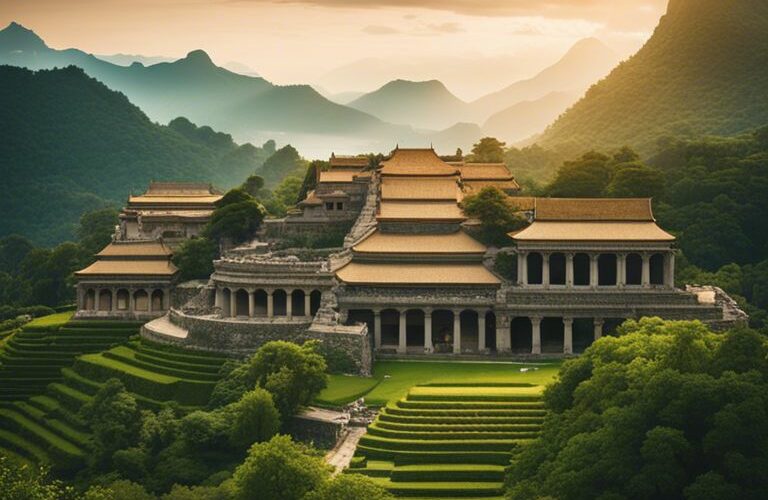There’s an undeniable connection between ancient civilizations and nature that has shaped the way societies interacted with their environment for centuries. From the awe-inspiring Mayan ruins to the mystical Stonehenge, ancient cultures around the world were deeply rooted in their natural surroundings, often worshiping and respecting the elements that sustained their livelihoods. By understanding how these civilizations lived in harmony with nature, we can gain valuable insights into sustainable practices that can be applied in our modern world to protect our planet for future generations.
Table of Contents
Spiritual and Mythological Connections
The ancient civilizations had deep-rooted spiritual and mythological connections with nature, viewing the natural world as a manifestation of divine forces. These beliefs often shaped their understanding of the world around them and influenced their daily lives.
Nature Deities and Mythical Beasts
For the ancient civilizations, nature was not just a physical entity but also a realm inhabited by deities and mythical beasts. These beings were believed to control various aspects of nature, such as the sun, moon, oceans, and forests. The worship of these deities was crucial for ensuring harmony and balance in the natural world.
Stories of mythical beasts like dragons, unicorns, and phoenixes were prevalent in ancient mythologies, symbolizing the power and mystery of nature. These creatures often served as protectors of sacred places and were revered for their supernatural abilities.
Sacred Spaces: Forests, Mountains, and Rivers
The ancients revered certain natural spaces, such as forests, mountains, and rivers, as sacred sites imbued with spiritual significance. These locations were believed to be the dwelling places of deities or the gateways to the divine realm. Rituals and ceremonies were performed in these areas to honor and communicate with the gods.
For instance, the ancient Greeks considered Mount Olympus as the home of their gods, while the Egyptians revered the Nile River as a lifeline that sustained their civilization. These sacred spaces served as a connection between the earthly and spiritual realms, fostering a deep respect for nature and its power.
Agriculture and Seasonal Cycles
Now, let’s probe into how ancient civilizations cultivated a harmonious relationship with nature through agriculture and seasonal cycles. By understanding the land and its rhythms, these civilizations were able to thrive and sustain their societies for generations to come.
Ancient Farming Techniques and Sustainability
On the quest for sustainable practices, ancient farmers employed various techniques to ensure the fertility of their land. Practices such as crop rotation, terracing, and irrigation were essential in maximizing yields while preserving the soil’s nutrients. Through trial and error, these civilizations honed their agricultural skills, creating a balance between cultivation and conservation that is awe-inspiring even by modern standards.
To fully appreciate the significance of ancient farming techniques, it’s crucial to understand the immense impact they had on shaping the landscape and ecosystems of their time. The sustainability of these practices not only ensured the well-being of the people but also contributed to the overall harmony between humanity and nature.
The Calendar: Alignments and Celebrations
On the subject of seasonal cycles, ancient civilizations developed calendars that aligned with the changing patterns of nature. These calendars were not just tools for tracking time but served as guides for agricultural activities, religious ceremonies, and community celebrations. The alignment of the calendar with the natural world was pivotal in ensuring the prosperity and unity of these societies.
This intricate connection between the calendar and natural cycles allowed ancient civilizations to anticipate changes in weather patterns, planting seasons, and harvest times. By honoring these alignments through rituals and celebrations, these cultures emphasized the importance of living in harmony with the Earth’s rhythms and cycles.
Architectural and Engineering Marvels
Designing with the Environment
Unlike modern construction practices that often disregard the environment, ancient civilizations crafted their architectural wonders in harmony with nature. From the grand pyramids of Egypt to the intricate temples of Angkor Wat, these structures were intricately designed to blend seamlessly with the surrounding landscapes.
To achieve this, architects and engineers of the past carefully studied the natural elements of the location where they planned to build. They incorporated natural features such as rivers, mountains, and sunlight into their designs, creating structures that not only stood the test of time but also enhanced the natural beauty of the environment.
Harnessing Natural Resources: Water Systems and Energy
Resources were highly valued by ancient civilizations, and they ingeniously developed sophisticated water systems and energy solutions to sustain their societies. Civilizations like the Romans constructed aqueducts to transport water over long distances, while the Mayans utilized advanced irrigation techniques to support their agricultural practices.
Plus, ancient civilizations utilized renewable energy sources such as wind and solar power to meet their energy needs. They built structures with strategic orientation to capitalize on natural light and ventilation, reducing the reliance on artificial lighting and cooling systems.
Additionally, the use of hydropower through water mills and aqueducts allowed for the efficient harnessing of energy from flowing water, powering various industrial processes and improving overall sustainability.
Artistic Expressions and Natural Materials
After exploring the harmonious relationship between ancient civilizations and nature, it is evident that artistic expressions have played a crucial role in this interaction. Ancient cultures have long drawn inspiration from the natural world, using a variety of materials sourced from the environment to create stunning works of art.
Depictions of Nature in Art and Literature
Nature has always been a central theme in the artistic and literary works of ancient civilizations. From the intricate cave paintings of early humans to the detailed hieroglyphs of the ancient Egyptians, representations of the natural world can be found throughout history. These depictions often served as a form of reverence for the beauty and power of nature, showcasing the deep connection that early societies felt with their environment.
In literature, ancient civilizations often used nature as a source of inspiration for their myths, poetry, and storytelling. The Greeks, for example, attributed supernatural powers to natural elements such as trees, rivers, and mountains, weaving them into their epics and dramas to convey important moral lessons and philosophical ideas.
Utilization of Natural Resources in Craftsmanship
An important aspect of the harmonious relationship between ancient civilizations and nature was the utilization of natural resources in craftsmanship. Various cultures developed sophisticated techniques for working with materials such as wood, stone, clay, and metals, transforming them into intricate artifacts, tools, and structures.
Resources such as jade, obsidian, gold, and silver were highly prized for their aesthetic qualities and symbolic meanings. These materials were often reserved for the creation of ritual objects, royal regalia, and religious artifacts, highlighting the significance placed on the natural world in the spiritual and artistic expressions of ancient societies.
Ecological Wisdom and Conservation Efforts
Keep in mind that the ancient civilizations had a deep understanding of the interconnectedness of all living beings and their environment. They recognized the importance of maintaining a harmonious balance between human activities and nature to ensure the sustainability of life on Earth.
Preserving Biodiversity: Lessons from the Ancients
Biodiversity was a fundamental concept for many ancient civilizations, who understood the value of preserving the variety of plant and animal species in their surroundings. They implemented practices such as protecting natural habitats, regulating hunting and fishing, and cultivating diverse crops to maintain a rich biodiversity.
Ancient Strategies for Environmental Stewardship focused on long-term sustainability and conservation of natural resources. They developed innovative methods such as crop rotation, terracing on hillsides to prevent erosion, and creating artificial wetlands to support wildlife populations.
Ancient Strategies for Environmental Stewardship
Efforts to preserve the environment were ingrained in the daily lives of ancient civilizations. They viewed themselves as caretakers of the land, responsible for passing on a healthy ecosystem to future generations.
Ancients believed in the importance of respecting nature’s cycles and adapting their behaviors to live in harmony with the environment. Their holistic approach to conservation serves as a timeless reminder of the wisdom we can still learn from today.
Summing up
Upon reflecting on the harmonious relationship between ancient civilizations and nature, it becomes evident that our ancestors possessed a deep wisdom and respect for the natural world. From the Egyptians and their eco-friendly agricultural techniques to the Greeks and their belief in the interconnectedness of all living things, these ancient cultures serve as a reminder of the importance of living in harmony with our environment. By studying their practices and beliefs, we can gain valuable insights into how to better care for the planet and create a more sustainable future for generations to come.
FAQ
Q: What is the harmonious relationship between ancient civilizations and nature?
A: The harmonious relationship between ancient civilizations and nature refers to the interconnectedness and balance that existed between human societies and the natural environment in the past. Ancient civilizations understood the importance of living in harmony with nature to ensure their survival and prosperity.
Q: How did ancient civilizations view nature?
A: Ancient civilizations viewed nature as sacred and essential to their way of life. They believed in the interconnectedness of all living things and the environment, viewing nature as a source of inspiration, wisdom, and sustenance.
Q: What are some examples of how ancient civilizations interacted with nature?
A: Ancient civilizations interacted with nature in various ways, such as practicing sustainable agriculture, building structures in harmony with the natural landscape, and developing spiritual beliefs and rituals that honored the natural world.
Q: How did ancient civilizations incorporate nature into their cultural practices?
A: Ancient civilizations incorporated nature into their cultural practices through art, architecture, mythology, and religious ceremonies. They celebrated the changing seasons, honored natural elements like the sun and moon, and told stories that reflected their deep connection to the natural world.
Q: What lessons can we learn from the harmonious relationship between ancient civilizations and nature?
A: We can learn valuable lessons from ancient civilizations about the importance of respecting and preserving the natural environment. By studying how our ancestors lived in harmony with nature, we can gain insight into how to create a sustainable future for ourselves and future generations.

Our contributing author is a passionate advocate for eco-friendly living and sustainability. With a background in eco-life, they are dedicated to inspiring and empowering individuals to adopt environmentally conscious lifestyles. Through insightful articles, they share practical tips, innovative solutions, and thought-provoking perspectives to promote a greener, more sustainable world. Join them on the journey towards eco-smart living and discover how small choices can make a big impact. 🌱








